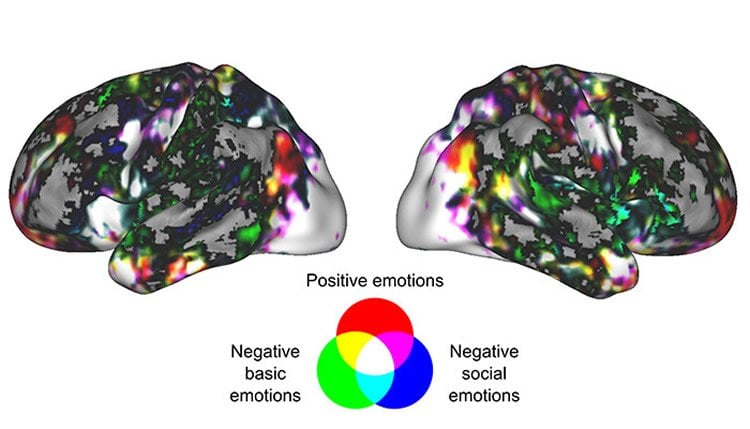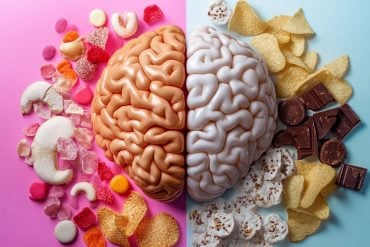Summary: A new study reports basic emotions, such as happiness and anger, are not limited to specific regions, but have distinct connectivity patterns that encompass much of the brain.
Source: Aalto University.
In the field of affective neuroscience, rivalling theories debate whether emotional states can be regarded as an activity of only certain brain regions. According to a new doctoral dissertation at Aalto University, an emotional state affects the operation of the entire brain instead of individual emotions being localised only in specific regions in the brain.
‘From the biological point of view, an emotion is a state of the entire brain at a given moment. For example, the brain may interpret certain action models, memories and bodily changes altogether as anger,’ explains Doctoral Candidate Heini Saarimäki.
Different emotional states of the participants were evoked with films, mental imagery or guided imagery based on narratives. After that, a classifier algorithm based on machine learning was trained to connect the specific emotions and the brain data related to them. The classifier algorithm was then tested by giving it new brain data and by measuring how successfully the algorithm recognised the correct emotion solely on the basis of the brain data. The method for measuring brain activity is based on measuring the changes in the blood oxygen content in the brain and it provides information on the activation of the brain with millimetre-accuracy.
The researchers were particularly interested in emotion-specific brain maps, that is, maps on the localisation of emotions in various areas across the entire brain. By analysing the activity of the entire brain, a machine learning algorithm may be able to determine the emotional state in question.
Saarimäki and her colleagues discovered that the brain maps of basic emotions such as anger, happiness, sadness, fear, surprise and disgust were to some extent similar across people. Basic emotions seem to be at least partially biologically determined, whereas social emotions – gratitude, contempt, pride and shame – are to a greater extent built on experience. In social emotions, the differences in brain activity between people are greater than in basic emotions.
From groups of similar emotions to the power of empathy
The classifier algorithm makes more mistakes with distinguishing emotions that have similar brain maps than with emotions whose brain maps have little in common. This information can be further compared to how people interpret certain emotions subjectively. Positive emotions, such as happiness, love, gratitude and pride, are more similar both as subjective experiences and at the level of brain activity. Negative emotions, such as fear, anger and sadness, on the other hand, have as a group a similar basis in brain activity. The brain activities during negative social emotions such as shame, guilt and contempt, in turn, resemble each other most but differ from the brain maps of basic negative emotions.

‘We also discovered that the accuracy of emotion classification seems to be related to individual differences in emotional processing, such as in the ability to feel empathy. We want to examine in more detail how individual differences, for example in empathy, are linked to the functioning of the emotional systems of the brain. A separate research project investigating this is about to begin,’ Saarimäki explains.
The results of the study benefit the treatment of mental health disorders or memory loss diseases, which both appear to be clearly connected to emotional disorders. A better understanding of the brain mechanisms of different emotions may be helpful in planning and targeting treatment correctly.
Source: Aalto University
Publisher: Organized by NeuroscienceNews.com.
Image Source: NeuroscienceNews.com image is credited to Heini Saarimäki..
Original Research: An abstract for the dissertation is available online.
[cbtabs][cbtab title=”MLA”]Aalto University “Love and Fear Are Visible Across the Brain, Not Restricted to One Region.” NeuroscienceNews. NeuroscienceNews, 17 February 2018.
< https://neurosciencenews.com/love-fear-brain-8514/>.[/cbtab][cbtab title=”APA”]Aalto University (2018, February 17). Love and Fear Are Visible Across the Brain, Not Restricted to One Region. NeuroscienceNews. Retrieved February 17, 2018 from https://neurosciencenews.com/love-fear-brain-8514/[/cbtab][cbtab title=”Chicago”]Aalto University “Love and Fear Are Visible Across the Brain, Not Restricted to One Region.” https://neurosciencenews.com/love-fear-brain-8514/ (accessed February 17, 2018).[/cbtab][/cbtabs]
Abstract
Decoding emotions from brain activity and connectivity patterns
Emotions guide both human and animal behavior providing the means for survival in a constantly changing environment. Different emotions seem to be distinct from each other in several aspects, including physiological changes, bodily sensations, facial expressions, and subjective experience. Whether and how such emotion categories exist at the neural level remains however under debate. The goal of this dissertation was to employ pattern classification methods to investigate the neural underpinnings of different emotion states. Specifically, it was hypothesized that if different emotions have distinct neural bases, we should be able to reliably classify them from brain activity and connectivity patterns. Further, it was hypothesized that the classifier confusions presumably reveal which emotions have similar neural substrates.
Multiple emotional states were induced in four studies with altogether 109 participants using emotional movies, mental imagery, and narratives while participants’ brain activity was measured with functional magnetic resonance imaging (fMRI). Several approaches to the fMRI data analyses were employed: multivariate pattern classification to distinguish voxel activity and functional connectivity patterns underlying different emotions, representational similarity analysis to compare experienced and neural similarity of different emotions, functional connectivity analysis to reveal emotional modulations in brain connectivity, univariate methods such as general linear model (GLM) to visualize the neural substrates of different emotions, and correlation analyses to compare the relationship of different emotions at different emotion-related components.
Results from these studies show that specific emotions can be classified from both voxel activity and functional connectivity patterns. Successful pattern classification of voxel activity across the whole brain shows that different emotions have distinct brain activity patterns that generalize across participants and across emotion induction techniques. Further, emotions that subjectively feel more similar also have more similar neural underpinnings. Functional connectivity is modulated by emotional content and shows distinct patterns for different emotions especially within the default mode network (DMN). DMN regions especially in the cortical midline, together with somatomotor, sensory, and subcortical areas, support most emotions. Finally, distinctness of emotions is related at the level of different components, including facial expressions, bodily sensations, emotional evaluations, subjective experiences, and neural substrates.
To conclude, emotions have distinct brain activity and connectivity patterns that encompass large extent of the brain. Emotions can thus be viewed as systemic states that, at a given moment, facilitate and constrain other mental functions.






